 When several feet of beautifully braided wire are wrapped several times around a form and secured you have the makings of a unique and interesting handmade ligature. How does it work? How secure is the reed to mouthpiece fit? Can it be adjusted easily and repeatably? Can it withstand the rigors of the bandstand? These are the questions that I ask of any ligature I get. Now, that I’ve had one for the past several weeks I have the answers to these questions.
When several feet of beautifully braided wire are wrapped several times around a form and secured you have the makings of a unique and interesting handmade ligature. How does it work? How secure is the reed to mouthpiece fit? Can it be adjusted easily and repeatably? Can it withstand the rigors of the bandstand? These are the questions that I ask of any ligature I get. Now, that I’ve had one for the past several weeks I have the answers to these questions.
Before I begin I have to reassert that I do not feel that ligatures make much of a difference in the sound of a saxophone short of the placebo effect. That said, they do make a difference in how a player interacts with the instrument. How a mouthpiece is to play and how hard the player has to work to get their desired tone can also be effected by a poor fitting or poorly designed ligature. Ultimately the ligature just has to stay in place and keep the reed positioned securely.
The ligature came in a small pouch within the retail box. This pouch while being a good storage option for some I found it to be not enough protection for the medium soft ligature. I prefer to keep formed ligatures like this on a mouthpiece with a cap. This way they will keep their shape and will not get crushed in a bari case or underfoot. Thing to note, the ligature did not come with a cap. I recommend the generic flexible plastic cap that you can get cheaply from your local music store or online retailer. The best cap is one with a relief cut to allow for maximum compatibility. See the image below.

For test purposes I placed the ligature on a Rico Graftonite and Metalite mouthpieces. Because the material these mouthpieces are made of is durable I can discover rather quickly if the ligature will scratch a hard rubber mouthpiece. The reed I used for this test was a synthetic Bari brand baritone reed. This combo has a tendency to move around a lot with just about any ligature that is not made of leather.
Using the ligature could not be easier. The ligature has a top knot where the wires making up the ligature are brought to a knot and soldered together. With the knot on the top you slip on the ligature, which is tapered like the mouthpiece, then slide the reed underneath it. Then cinch down the ligature by pushing it towards the bottom of the mouthpiece. It is best to do the procedure with the mouthpiece off of the horn as you will almost certainly push the mouthpiece down further on to the cork of the neck if you do it with the mouthpiece on the horn.
How well does this ligature do it’s primary function of keeping the reed secure to the mouthpiece? Surprisingly well when cinched down. The ligature can conform to the reed and mouthpiece slightly creating an interface that is secure without applying too much clamping force. Even when secured you can still adjust the left and right alignment of the reed on the mouthpiece.
I decided to run a utility test of how long it would take to remove and install a reed on this ligature while in a playing situation. When playing long gig I usually have to change my synthetic reed every so often. Armed with a stopwatch I asked a friend to time the procedure going from a playing state to a playing state after a reed swap. The results were not surprising. It took on average 14.5 seconds to remove the reed from the mouthpiece and to realign, cinch, and be ready to play with the EGR ligature. Compared to a Rovner Dark at 10 seconds, and a traditional 2 screw ligature at 13 seconds it was perfectly within a 24 to 32 bar break that I often find myself in on some big band charts. I will say that I am very familiar with both the Rovner and 2-screw ligatures so my time with them is based on years of practice. It is quite possible that I would see speed increases with the EGR if I spent more time with it.
Repeatability on this ligature was okay, better than the Rovner but not as repeatable as the 2 screw. Getting the ligature to the exact same spot after a reed swap was easiest with a 2-screw but hardest with the Rovner as I tended to unscrew them a lot more than necessary when removing them. The EGR ligature will only go so far onto the mouthpiece. After a few cinching down the ligature with naturally land at or near the same position depending on the reed. If the old and new reeds have the same thickness and profile then the ligature will land in almost the same spot every time.
With no moving parts this ligature will provide years of maintenance free operation. The only caveat is that if you intend to use this ligature that you should be careful using it on mouthpiece with soft finishes like gold. The wire is aluminum but if your mouthpiece is gold plated then it could put fine abrasions in it. This is purely speculation but I feel I would be doing a disservice if I didn’t raise concerns. As of yet I have not seen any abrasions on my non-metal mouthpiece yet.
TAKE AWAY: This ligature is equal parts saxophone jewelry and functional accessory. It clamps with just enough pressure to secure the reed without strangling it. I have just two negatives though. The first is the lack of a cap. If a cap were included I think it would have really made this an even better buy. Secondly, I’d love to have a way to tighten the clamping force beyond the normal amount when desired as some reeds respond better to more force. I say try one and see if it meets your needs.

